 |
| October 29, 2019 | Volume 15 Issue 41 |
Designfax weekly eMagazine
Archives
Partners
Manufacturing Center
Product Spotlight
Modern Applications News
Metalworking Ideas For
Today's Job Shops
Tooling and Production
Strategies for large
metalworking plants
Audi unveils autonomous off-roading concept
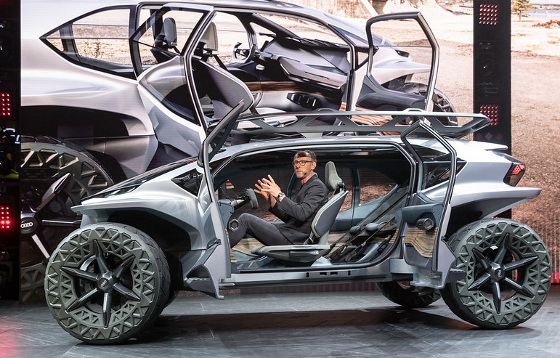
Marc Lichte, Head of Audi Design, revealed the Audi AI:TRAIL quattro concept at the International Motor Show (IAA) 2019 in September in Frankfurt, Germany.
We've seen a bunch of electric vehicle concepts with automated driving rolled out lately, from super-high-end luxe cruisers to cutesy micro-cars that just get the job done. Audi took another direction at the International Auto Show in September by introducing its AI:TRAIL quattro concept. With its fortified suspension and tires, 360-degree "helicopter" views, and integrated drones, it's weird vs. the wild for the future of off-roading.
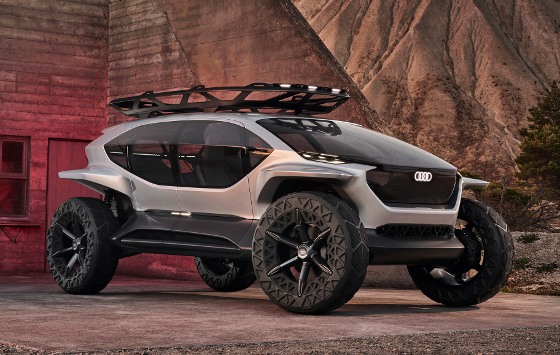
It's great that Audi rolled out a physical prototype, because this vehicle is bigger than it looks in preliminary renderings. At 13.5 ft long and 7 ft wide, and with a roof height of 5.5 ft, the AI:TRAIL is way more than a dressed-up ATV. It looks downright brawny on it's 22-in. wheels, with a ground clearance of 13.4 in.
Designed to go the distance
The performance specs for the AI:TRAIL are markedly different from those for conventional electric vehicles -- and it's battery life reflects it. That's because the car's developers say the goal was not about achieving remarkably quick acceleration or hitting blazing speeds on the autobahn.
Since there are no electric charging stations in the middle of nowhere, the engineers had to concentrate on range. The stated target of the AI:TRAIL's lithium-ion battery, which is built into the floor of the vehicle, is 400 to 500 km (248.5 to 310.7 miles) on roads or easy off-road terrain. On rough ground, where the almost constantly elevated wheel slip alone means that energy consumption is higher, the limit is still an impressive 250 km (155.3 mi).
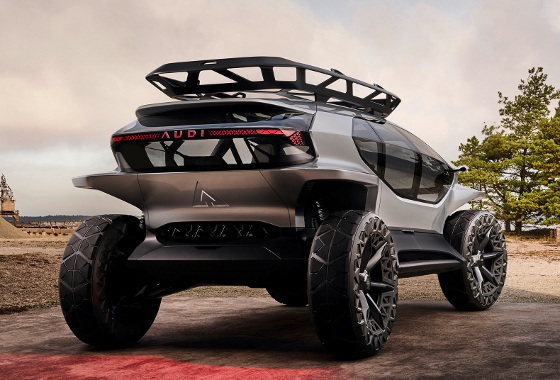
In order to meet these requirements, the vehicle is designed to reach a max speed of 130 km/h (80.8 mph) on the road. The vehicle electronics continuously monitor the energy flow and consumption, thereby ensuring maximum economy even during off-road driving. But don't use all your juice on the pavement!
In terms of drive hardware, the AI:TRAIL is equipped with four electric motors installed near the wheels, with each propelling one wheel directly -- making this off-roader a true Audi quattro. The maximum system output is 320 kW, and the maximum torque is 1,000 Nm (737.6 lb-ft). Since only a fraction of this power is usually mobilized; the drive of just one axle is often sufficient to get a lot of tasks done.
Due to the individually propelled wheels, the vehicle can do without differentials and locks, which also consume energy. Thanks to the moderately calculated maximum speed, the gear ratio has been designed so that every wheel is provided with enough torque, even without a multi-speed transmission.
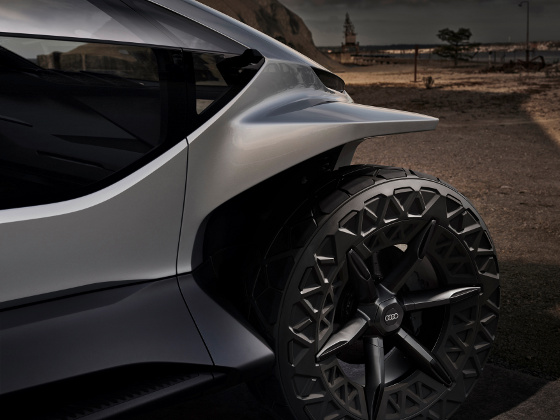
The electronics coordinate driving stability and traction. If energy-consuming slip can be avoided, it reduces the supply of torque to the affected wheel. However, in situations in which slip is useful, such as on low-grip uphill stretches, the system permits it automatically. The large amounts of reserve power of the AI:TRAIL allow it to conquer challenging stretches even in difficult conditions safely and with confidence.
Bulky transverse links and MacPherson suspension struts with coil springs and adaptive dampers provide reliable stability for heavy-duty driving done safely. A special, rugged tire design features variable, sensor-controlled air-pressure regulation. Optical sensors and electronic stability control (ESC) work together to detect the condition of the road surface and adjust the air pressure in the tires accordingly. If extra traction is needed (for driving in sand, for example), the tire pressure can be reduced to increase the tire contact patch. By the same token, increasing the pressure again when switching to asphalt increases drive stability.
And since most all of this is taking place outdoors, it's nice to know that these functions are performed without emissions.
Kind of like a modern ferris wheel gondola
The cabin itself is a sweeping glazed space surrounded by polygonal shapes, with room for up to four people. One characteristic feature is the protruding ridge halfway up the side windows. This line continues to both the front and rear and acts as a waistline that unites the entire body into a whole. With the electric drive system arranged around the axles and the battery in the floor, there is no need for overhanging sections or separate attachments for the motor or batteries. Audi designers say this one-box design is "becoming the gold standard for the age of the electric vehicle."
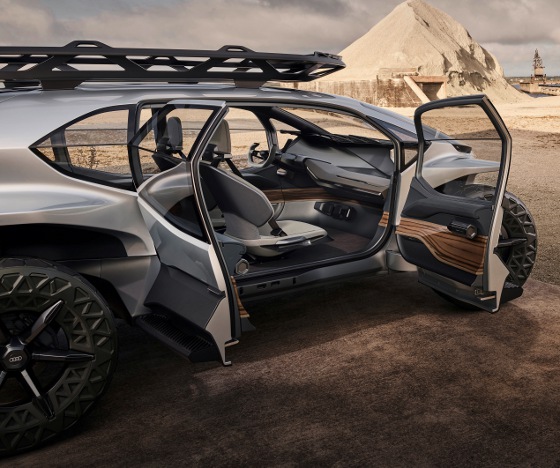
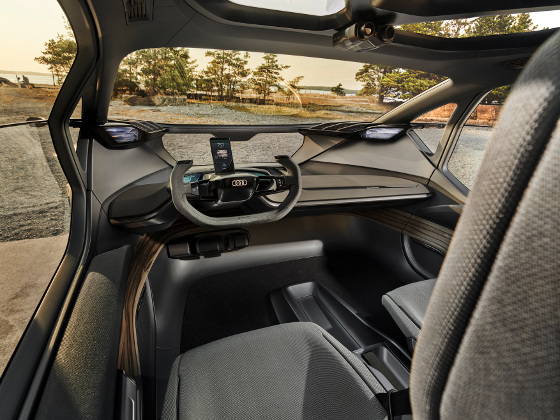
The body of the AI:TRAIL is made of a mixture of high-tech steel, aluminum, and carbon fiber. It weighs 1,750 kg (3,858 lb), including its high-capacity battery.
The windshield wraps around the front of the vehicle like the cockpit of a helicopter. Passengers have an unobstructed view of the road or trail both in front and to the sides. Almost the entire roof, from the top of the windshield to the rear spoiler, also allows a clear view of the sky and the landscape -- so don't forget that sunscreen!
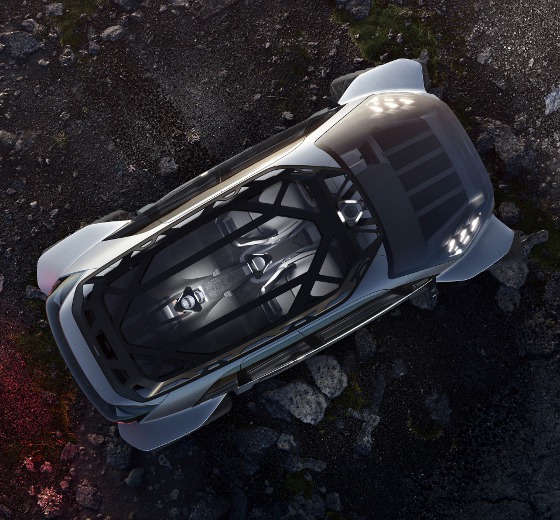
Both the windshield and the tailgate open wide, providing easy access to large storage compartments with straps to keep luggage secure in transit. Integrated in the bumper at the rear is another separate compartment for boots, climbing gear, or extra snacks.
The side sills beneath the opposing doors act as retractable running boards. This makes it easier to load and unload the roof rack. Instead of bulky wheel wells, horizontal fenders are all that sit above the four wheels. That makes it possible to see the suspension in action from the cockpit even during travel.
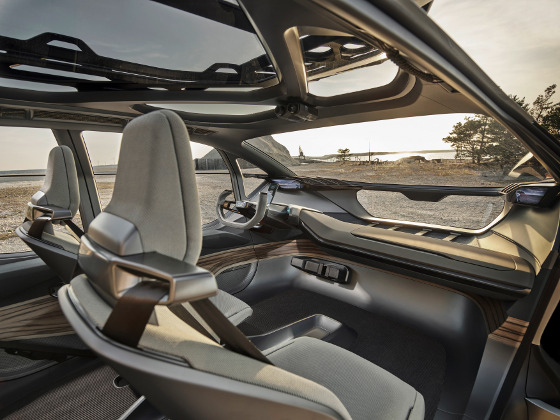
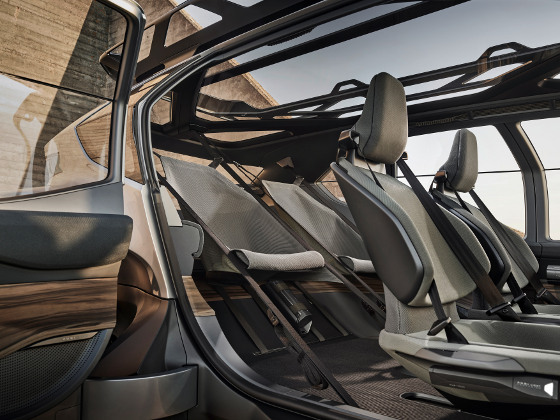
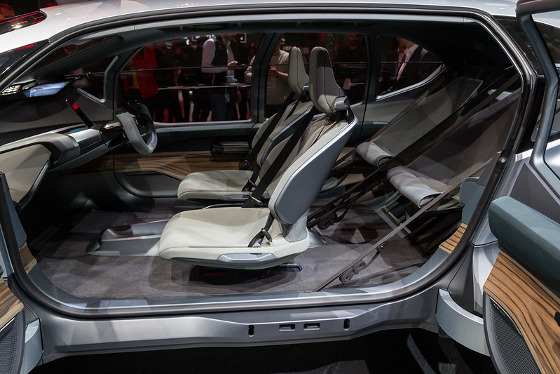
Instead of conventional headlights, self-contained light sources sit below the A-pillars and can shine both outward and inward. These LED elements are dimmable and adjustable and can be used as interior lighting as well as for lighting the vehicle's path. The rear light operates in a similar way.
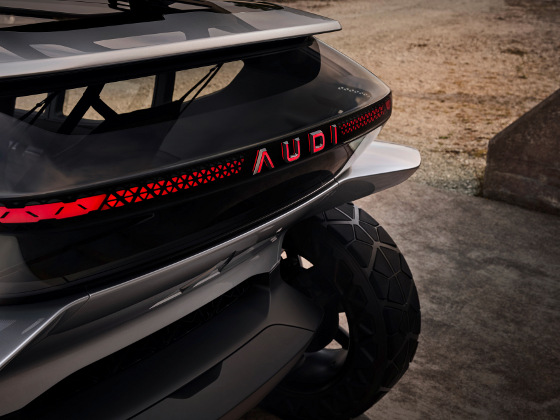
Comes with pet drones
Instead of conventional low beams and high beams, the Audi AI:TRAIL is equipped with a total of five rotorless, triangular, lightweight electric drones with integrated matrix LEDs. They work similarly to how bladeless fans produce their air flow. They are capable of landing on a roof rack or directly on the roof of the vehicle and docking onto the inductive charging elements. Audi calls these "Pathfinders," and they can fly ahead of the AI:TRAIL to illuminate the path ahead. Their on-board cameras can generate a video image that can be transmitted to the display in front of the driver via Wi-Fi, turning the Pathfinders into "eyes in the sky."
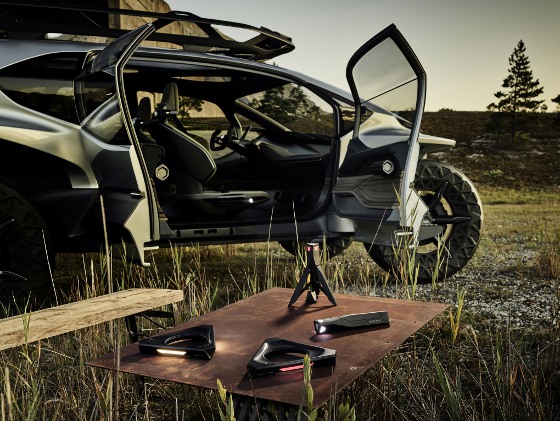
Let AI take the wheel -- sometimes
The Audi AI:TRAIL is designed for driving on roads up to level 4, the second-highest level on a standardized international scale for increasing automation. Although systems in this category do not require any assistance on the part of the driver, their function is limited to a specific area, such as highways or areas of inner cities equipped with suitable infrastructure. In these places, the driver can completely transfer the task of driving to the system.
Even though many unpaved dirt tracks and forest paths have been mapped extensively through digital cartography, the way in which their surfaces frequently erode makes them too variable to allow automated driving reliably for any extended period. Automated driving in the reduced-speed level 3 range is possible on dirt roads only in exceptional cases and at low speeds. In these situations, the driver will have several seconds to take over.
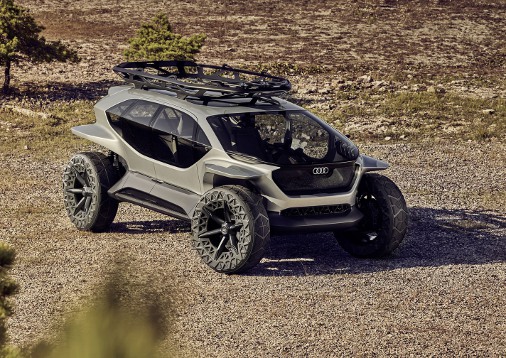
But the sensors and assist systems don't leave the driver of the AI:TRAIL alone, even off-road. First of all, there is the tried-and-tested sensor system for the Electronic Stability Program (ESP) on board. The data for friction values and slip, and longitudinal and lateral acceleration, provide the electronics with all necessary parameters they need in order to optimize drive stability. There is also a whole range of sensors that can detect both the road surface and obstacles. They work together with optical systems such as cameras and lasers, as well as with ultrasound and radar. The data they provide enables the central driver assistance system to avoid collisions by intervening with the steering and braking as needed.
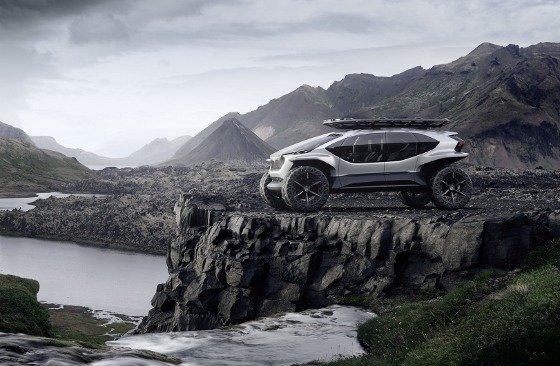
The electronics also assist the driver with conquering uneven stretches. For example, when the vehicle is in a tilted position or on particularly challenging inclines, the systems warn the driver when critical limits are about to be exceeded, such as ground clearance or angles of incidence that are difficult to control. They can also keep the vehicle on track, within the limits of the system, much like a lane-keeping assist working in concert with cruise control. Depending on the circumstances, this puts the vehicle at automation level 2. However, it requires the driver to be paying attention at all times. According to the designers, the smart assistance systems do provide effective support, definitely help to improve safety, and take a significant amount of the strain off the driver.
So what do you think? Should we set that GPS in an AI:TRAIL, sit back, and relax to go explorin'? We can pretend we're the Robinson family from "Lost in Space," because this really looks like something they would drive. It's a good start to look at how next-gen systems can work in the great outdoors -- and beyond.
But let's hope that in the future someone saves a good-ole 1990s Ford or Chevy pickup for muddin'. We're still gonna need that.
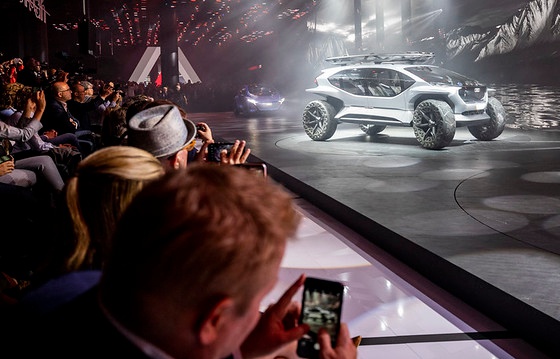
Source: Audi
Published October 2019
Rate this article
View our terms of use and privacy policy
